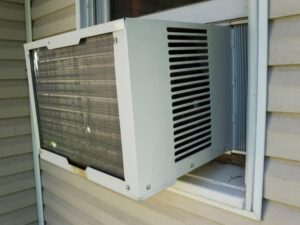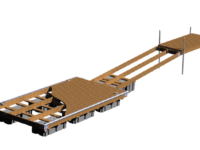Hiring a Professional for Air Conditioning Installation
Air Conditioning Installation involves a number of steps and is complex enough to require the expertise of a professional. Hiring one can prevent you from accidentally making costly mistakes that could cause your new system to perform poorly or even damage your home.
A professional should start with a manual load calculation to determine what size unit your home needs. This is important, as an improperly sized AC can increase your energy costs significantly.
Air conditioning installation costs can quickly add up, especially for larger homes or those with extensive ductwork. Fortunately, there are ways to cut some of these costs by shopping around and considering a few financing options. A new air conditioner is a significant investment that will have a long-term impact on your home’s value and energy bills.
The total cost of an AC system varies based on the size and efficiency of the unit as well as labor fees. The least expensive air conditioner brands average about $1,400, while the most expensive models are about $10,000. Adding or updating ductwork can also significantly increase installation costs, as it will require more time and labor than installing an AC unit without existing ducts.
In addition, a central AC system requires a hard-wired, dedicated electrical circuit with a standard 240-volt connection and 15 to 60 amps of power, depending on the unit size. The cost of hiring a local electrician to install this electrical outlet will range from $100 to $150. If you’re replacing an older furnace and air conditioning unit, it makes sense to purchase a “matched” system that will include both units and allow for optimized heating and cooling efficiency. This can save you money in the long run by reducing both your energy costs and maintenance expenses.
Another factor that impacts AC installation costs is the energy efficiency, or SEER, rating of the unit. High-efficiency models are more costly to install than traditional units, but they help lower your energy bills by lowering energy consumption. You can often save even more money on the cost of an air conditioning system by purchasing a model that has earned the ENERGY STAR label, which is granted by the federal and state governments.
Whether you opt for a central or ductless system, the installation process is complex and should be completed by a licensed professional to avoid potentially dangerous mistakes. It’s important to shop around and gather quotes from several HVAC contractors before making a final decision. If you are looking to save on installation costs, you can always try DIY air conditioner installation for portable units and smaller window installations. However, this is only appropriate for those with experience in the plumbing and electric work required.
Energy Efficiency
Air conditioning is one of the largest energy users in a home, and a large portion of that usage occurs during the summer months. Upgrading to a more efficient unit can significantly lower energy bills and also save on maintenance costs.
The determining factor for an AC’s energy efficiency is its seasonal energy efficiency ratio, or SEER rating. The higher the SEER, the more efficient the unit. SEER ratings are determined by comparing the cooling output in BTU during the season to the system’s electric energy input.
In order for an air conditioner to receive ENERGY STAR certification, it must be rated at 13 SEER or greater. However, there are also some units that can perform at up to 27 SEER. A newer air conditioner will typically have a higher SEER rating than an older model.
An upgrade to an energy-efficient air conditioner can also save on maintenance costs because the equipment will not have to work as hard. With proper yearly maintenance and tune-ups, an energy-efficient air conditioner can last up to 20 years.
A ductless air conditioning system can also be more efficient than a traditional AC unit because it only cools the areas of the house that are in use. This can reduce the amount of energy used to cool your entire home and may even be more cost-effective than cooling the whole house with a single AC unit.
While installing an energy-efficient AC will require a larger upfront investment, the savings on your utility bills can pay for it within a year or two. In addition, you may be able to qualify for rebates or incentives offered by your local utility company for making the switch. You can find more information about available programs by contacting your local energy provider or asking your HVAC professional.
Installation Process
Air conditioning installation involves several steps. First, the installer will assess your home to make sure it can adequately support a new system. This is important because it can help them find the best unit for your needs and avoid any potential setbacks that would increase the cost of the project.
Then, the professional will remove your existing air conditioner. This may include removing a concrete pad, drilling holes in the side of your house for the piping and cables to feed through, or even moving a roof deck if that is where the outdoor unit will go. They will then clean the area where the old unit was located and prepare for the new installation.
A new air conditioning installation involves a lot of heavy lifting, so it’s best to hire a professional. The expert will also take care of any required permits and paperwork that come with the project. In addition, the pro will make sure the installation site is safe. Since the AC unit will be using refrigerant, any professional who handles it must have a special EPA certification. This ensures that if any of the refrigerant is accidentally spilled, the person handling it has the necessary training and tools to properly dispose of it.
After the area is cleared, they will set up your new air conditioner on the composite pad they prepared earlier. Then, they will fit the copper line set and service rod into the valve of the air conditioner and melt them together, creating a leak-free connection. The installer will test the compressor and evaporator coil for any leaks or other problems before they finish.
If you are getting a new thermostat with your air conditioning installation, the professional will install it at this time. However, if you plan on keeping your current thermostat, the technician will only check to make sure the system’s connection to it is satisfactory.
Once the air conditioning installation is complete, your professional will walk you through what they’ve done and answer any questions. They will also let you know how often your new air conditioning system should be maintained to keep it running in peak condition.
Maintenance
An air conditioning installation is a complicated project that requires a lot of skill and experience. It’s important to hire an HVAC professional who knows how to install your AC system properly and will walk you through the process every step of the way. If you don’t, your system might not work properly and will be more likely to break down and require repairs in the future.
When an HVAC contractor is installing a central air conditioner or heat pump in your home, they’ll need to create a new space for the unit, frame the area for ductwork and insulation, and install a concrete pad for the outdoor compressor. They’ll also need to install new breakers in your electrical panel and run wires throughout the house to connect the air conditioner.
During the removal of your old air conditioner, they’ll clean up the area around the unit and dispose of all materials. They’ll also clean up any dirt and debris that has accumulated in the air vents. Additionally, they’ll replace any ducts that are dirty or damaged and do a visual inspection of the system to make sure everything looks good. If they see that there is a leak, they’ll seal it and add refrigerant as needed.
After the new equipment is installed, a technician will run it through a test cycle to check for any problems and make sure it’s working correctly. This will include checking that the thermostat is programmed and showing you how to use it. If they notice any problems, they’ll take care of them and get the unit back in operation as quickly as possible.
If you choose a company that offers a warranty on their AC installation, they’ll need to perform regular maintenance to keep the warranty valid. This will help your equipment last longer and prevent expensive repair bills in the future. Taking the time to keep up with air conditioner maintenance costs is an investment that will pay off in the long run.





